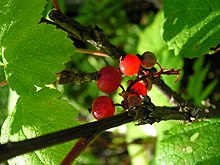| Ribes triste | |
|---|---|
 | |
 | |
| Scientific classification | |
| Kingdom: | Plantae |
| Clade: | Tracheophytes |
| Clade: | Angiosperms |
| Clade: | Eudicots |
| Order: | Saxifragales |
| Family: | Grossulariaceae |
| Genus: | Ribes |
| Species: | R. triste |
| Binomial name | |
| Ribes triste | |
| Synonyms [1] | |
| |
Ribes triste, known as the northern redcurrant, [2] swamp redcurrant, or wild redcurrant, [3] is an Asian and North American shrub in the gooseberry family.